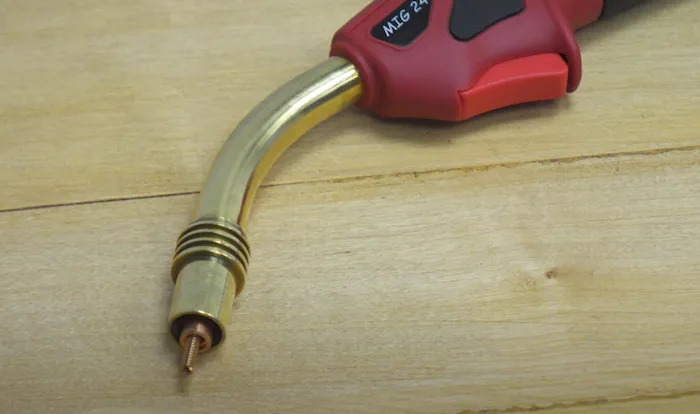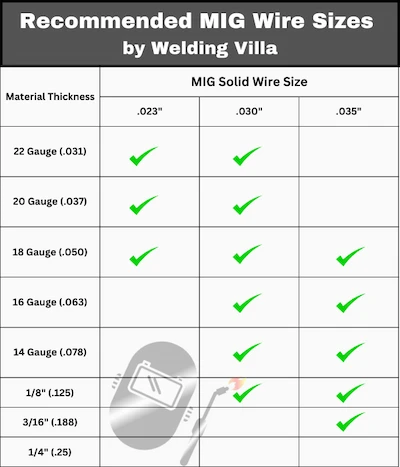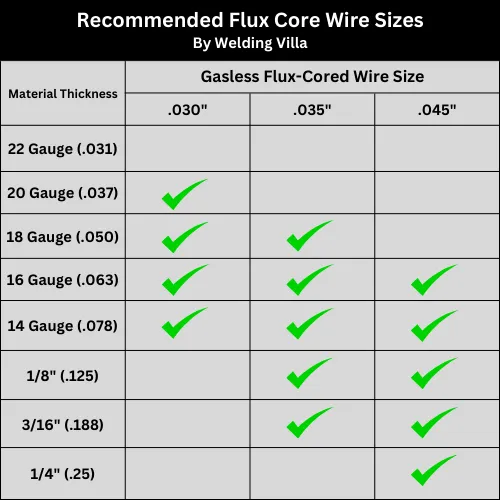MIG & Flux Core Welding Wire Types With Key Specifications (Guide with Chart)
Updated: 23 Nov 2023
183
MIG welding has different qualities and types of wires that have unique features. If you were also looking for a special wire for a mig welder, you end up at the right spot because we have a detailed guide.
Gas Metal arc Welding, usually known as MIG welding, is one of the most common types of welding that uses CO2 and Argon as its shielding gas. This process has automatic material filler instead of manual filler. That metal wire or filler rod has many types and variations, including flux core wire, which is essential to know about.
Different metal wires significantly impact their weld, like choosing flux core wire gives you weld without using shielding gas; that’s why selecting MIG welding wire is important. The wire selections for Mig welding can be determined based on project or system requirements. Choosing the suitable wire can make your weld stronger or weaker than you think.
After researching the topic, we have come to a detailed guide of types of wire for mig welding along with a detailed guide about flux core, so let’s get to it without wasting any time.
MIG Welding Wire Types:
The American Welding Society (AWS) has stated multiple classifications for solid wire for welding based on its chemical and mechanical properties. The classification names every wire in a particular set of letters and numbers, and each structure signifies a particular wire.
To know and understand every wire along its type, every welder must know at least its classification knowledge.

© weldingvilla.com – Image usage rights
| To understand its classification below, we have explained a basic common wire name AWS ER70S-3, in which |
|---|
|
After understanding the basics, it would be easy to understand the types of MIG wires on which metal is used.
MIG Wires for Steel:
The AWS A5.18/A5.18M document in the American Welding Society classifies the mild steel wires for MIG welding.
This classification shows the requirement of normal electrodes of carbon steel in the form of metal cored, composite stranded, and also in standard Gas metal arc welding or gas tungsten arc welding.
Sometimes, it can also be used with the Plasma arc welding process. In this specification, you will find the most widely used metal wires, which are given below.
It has normal applications, structural steel of MIG welding, piping, casting, forgings, etc. The 2 in its last represents that it needs pure argon gas for its shielding.
ER70S-3: This wire in MIG welding is used for most of its steel applications for general purposes. As a deoxidant, it has silicon, which is best for normal fabrications. This wire used Argon and CO2 mixture as shielding gas.
ER70S-4: This is a suitable wire filler area with a medium surface of contaminations like mil scale and rust. This wire has all the best qualities of S2 wires, including manganese, which makes it suitable for creating a high level of bread with a flatter surface.
ER70S-6: This wire is durable, solid, and considered an all-rounder because it is used almost everywhere in MIG welding, whether single-pass or multiple-pass welding. This wire also requires a Co2 and argon mixture. It also can withstand pure CO2 heat.
ER70S-7: This Steel-based wire is also a general-purpose MIG welding wire. It also contains a high level of manganese content, in fact, higher than ER70S-3, which is why it does better while welding and wetting appearance with high yield and tensile strength. This wire is used in automobiles, electric appliances, rolling stock, air conditioners, and other machinery.
Other than the above-listed wires, there are also other MIG wired based on Carbon steel, including ER70C-G and ER70-G. These wires are rarely used, and you are less likely to face them in your everyday welding, which is why we didn’t explain it.
Aluminum Wires for MIG Welding:

© weldingvilla.com – Image usage rights
You will need special aluminium wire Whenever you weld with aluminum wire. These wires are stated as A5.10 in the American Welding Society. These aluminum wires are different from previous steel wires. Why, you may ask? Well, it is because, in previous wires, you could weld multiple types with only one steel wire, while here, you will need a specific aluminum wire for each work.
Normally, MIG welding for aluminium only welds two basic types of aluminum wires, ER404 and ER5356.
ER4043: This is an aluminium welding wire that has 5% silicon, which is used with aluminum alloys 3003, 3004, 5052,6061,6063, along with casting alloys 43, 355, 356, and 214. The silicon in this aluminum plays an important role by providing high wetting for its welding and reducing the risk of weld cracking.
The ER4043 suits normal-purpose welding because its weld has less spatter, smut, and smooth surfaces. The melting point is lower than usual, which makes it good for brazing applications, but it doesn’t mean that it can’t be used in higher-temperature applications as compared to ER5356.
On the other hand, it has some drawbacks that make the aluminium wire alloy dark grey after its anodizing process; that’s why it’s not recommended to do this in colour areas. It is also considered soft compared to touch, then ER5356, which is one of the main reasons it causes tangling, clogging, birdnesting, etc.
ER5356: This aluminium wire contains up to 5% magnesium, which adds to the stability of its welding. The wire can be used for different types of aluminium alloys such as the 1XXX series, 5XXX series, 6XXX series, and curse 7XXX series.
This welding wire has a low melting point that provides strong welding, which is the best of thick materials that give you a tough time welding. Another thing that makes it the best is its corrosion resistance, which makes it withstand salt water.
Stainless Steel MIG Welding Wire:
Stainless steel has a specific grade and classification found in the American Welding Society A5.9/A5 document, which includes wire, strip, and welding consumables.
The common types of MIG stainless steel include ER308/308L, ER309, and ER16, which are below.
ER308/308L: This is one of the most common welding materials comprising 201,202, 301, 302, and 305. This welding wire is best for food processing, brewery, welding chemicals, and pharmaceutical stuff.
ER309: This welding alloy is similar to the previous one, but its use and application are different for them. This welding wire is specially used in straight chromium steels and other consumables.
Cast Iron MIG Welding Wires:
Welding with cast iron can be complex and unwanted because it has a 50% success rate and needs to be more balanced to keep its shape. That’s also the reason it doesn’t have too many filler options. However, it has been used in the welding market.
ERNi55: This welding wire combines nickel and iron, of which 45% is nickel and 55% is iron. The most common applications include repairing and fixing worn and broken parts.
ErNi-Fe-Cl: The welding wire is a high-end cast iron mainly used for malleable and ductile welding. It contains mainly nickel, with a rate of 99%. Its applications include fixing and repairing, detecting casting of machines, and its other build-up parts.
Copper MIG Welding Wire:
Mainly, copper is used for brazing or soldering, but it can be an excellent filler alloy for fusion methods, including TIG and MIG welding. A5.21 specifies the copper alloy for welding in the American Welding Society document. It has a lot of types, but we only discussed ERCu and ERSiCu because it is used at a beginner level.
ERCu: The basic use of this welding wire is repairing and deoxidizing copper casting with the TIG and MIG welding process. This copper welding wire is especially for overlaying the surfaces of stuff for billet molds, heater elements, conductor rolls, corrosion resistance, bus bars, copper connectors, etc.
ERSiCu: The welding wire is a combination of bronze and silicon that serves the purpose of welding silicon and copper alloys. Its usage includes fixing and joining coated steel to regular steel. Besides that, due to its high corrosion resistance, it is highly suggested and used in automotive, especially the surface areas.
Nickel Alloys Mig Welding Wire:
This MIG wire of Nickel alloy is specified by the American Welding Society in AWS A5.14 and A5.14M, including Nickel alloy, Bare welding Rods, and other MIG welding electrodes. There are only two of these wires defined below.
ERNiCr-3: This type of wire welds carbon steel to nickel chromium. It’s also one of the best wires that is a variety of different stuff ranging from cryogenic to high temperature. Most of its usage is in overlay applications.
ERniCRMo-3: This Copper alloy, also known as the Inconel 625, has been in the industry for a while. Its low iron content makes it suitable for welding or diluting iron. Its weld can resist pitting and corrosion because it also contains a high level of molybdenum. Also, check below the recommended MIG wire sizes chart.

Flux Core Wire:
Flux core is a type of welding wire that is a special ability used in Cored arc welding that is short for FCAW. Its tubular wire has a hollow core filled with flux material.
So what is special about it? Well, unlike other solid wires, it is one of the unique types of wire used in GMAW but doesn’t require any external shielding gas. The flux of that core produces a small protective atmosphere whenever it melts during its weld and then shields its weld pool from contaminations.
How Does it Work?
As mentioned above, in Welding with flux core wire, you don’t need any tank of CO2 and argon. You may think, why is that? Well, the core wire has some ingredients that are wrapped around it in the form of its coating.
So whenever the flux wire’s core melts, its outer layer melts along during the welding process. So when the flux melts, it releases gasses that create a protective shield of gas around that weld pool. This shielding gas prevents the weld from oxidation, defects, and atmospheric contamination.
So, in the presence of this flux core wire, you don’t need any shielding gas because it produces its own on the spot, and that’s why it is also called self-shielding gas or gasless welding gas. Also, check below the recommended flux-cored wire sizes chart.

FAQs:
Which wire is used in MIG Welding?
MIG welding uses different types of wire depending upon its metal. The common type of welding wire for MIG welding is ER308, ER309, ER308L, ER316, and so on. The most frequently used wires are ER308 and ER308L, which are used for almost everything.
What are the three types of MIG Welding?
There are a couple of types of welding, but three of its types are Pulsed MIG, Spray Arc Welding, and Globular welding.
What Size is a MIG Wire?
There are different variations of MIG wires, but the most common ones most frequently used are 0.30 inches, 0.23 inches, 0.45 inches, etc. Choose the one you require in all these variations and fulfil your needs.
Which Gas is used in MIG Welding?
Usually, MIG welding uses shielding gas, a mixture of argon and carbon dioxide. But sometimes, you can also use argon and helium for better grading.
Conclusion:
There are different types of MIG welding wire types, and choosing the right one is critical. That’s why you should know its applications, properties, and applications to get a better and stronger wire for your job.
If you need help figuring it out yourself, consult an expert if required. I hope you understand the topic, but please ask if you have any questions.
Please Write Your Comments